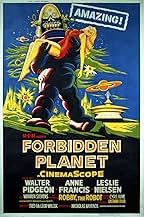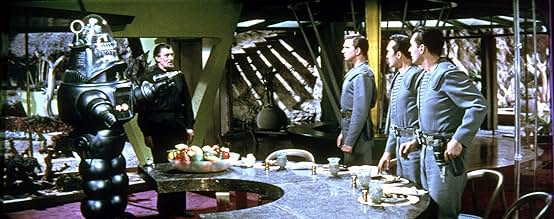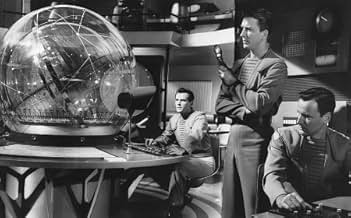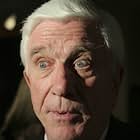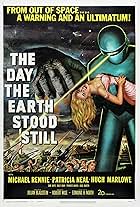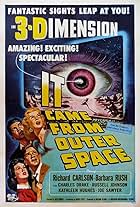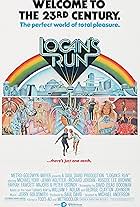A starship crew in the 23rd century goes to investigate the silence of a distant planet's colony, only to find just two survivors, a powerful robot, and the deadly secret of a lost civilizat... Read allA starship crew in the 23rd century goes to investigate the silence of a distant planet's colony, only to find just two survivors, a powerful robot, and the deadly secret of a lost civilization.A starship crew in the 23rd century goes to investigate the silence of a distant planet's colony, only to find just two survivors, a powerful robot, and the deadly secret of a lost civilization.
- Nominated for 1 Oscar
- 2 wins & 3 nominations total
George D. Wallace
- Bosun
- (as George Wallace)
Robert Dix
- Crewman Grey
- (as Bob Dix)
Robby the Robot
- Robby the Robot
- (as Robby The Robot)
James Best
- Crewman
- (uncredited)
Storyline
Did you know
- TriviaThe famous poster for the film shows a menacing robot carrying a struggling pretty girl - a staple of monster movie posters from the 1950's. In fact, no such scene occurs in the film itself and the robot portrayed in the poster is the very likeable Robby the Robot.
- GoofsWhen Doc describes their C-57D star ship's weapon capacity as 3 billion electron volts, that value is actually quite minuscule, something less than the energy expended by a flying mosquito.
For example, a weapon like a 20 kiloton nuclear detonation would be on the order of 10 to the 32 exponent electron volts.
- Quotes
Commander Adams: Nice climate you have here. High oxygen content.
Robby the Robot: I seldom use it myself, sir. It promotes rust.
- Alternate versionsWhe Metro-Goldwyn-Mayer reissued this film as part of a kiddie-matinée package, the scene where Jerry Farman cons the socially naive Altaira into kissing him was excised.
- ConnectionsEdited into The Twilight Zone: The Monsters Are Due on Maple Street (1960)
Featured review
If you like Star Wars/Trek, come see where they got all their ideas and cinematic devices. It's my top 2 favorite movies of all times, other-worldly-futuristic and psycho-thriller. The intensity of the root material (Shakespeare's "The Tempest") is not overshadowed by whizbang gimmickry (a la later Lucas). And just because it was made in 1956, don't assume you can 'see the strings' holding the flying saucer up. This was the first movie where you COULDN'T. Miracle it was made at "A-movie" scale, economics and tastes at the time were stacked heavily against it. And director Wilcox's previous 'hit' was "Lassie Come Home". Until I looked him up, I assumed 'Fred Wilcox' was a pseudonym for a director who was already or later became famous, but at the time didn't want to be associated with sci-fi, which was strictly a "B" genre back then. This was either a very VERY visionary production, or a very fortuitous 'mistake' on the part of the folks who bankroll Hollywood.
There are the massive-scale mattes with live action almost microscopically inserted that Lucas used extensively. There are intelligent machines that transcend the stereotypical 'user interface'; "computers", as they've come to be portrayed much less futuristically in later works. Star Trek's 'transporter' is there, visually, almost unaltered by Roddenberry 10 years later. And if the Trek/Wars technobabble turns you off, FP's scientific references are not overdone and are all accurate, even today. The "ship" set is comprehensive, sparklingly realistic, as good as anything you've seen since, and more convincing than anything 'Trek' has done, for TV or film. We didn't get to spend as much time there as I would have liked.
If you ever wondered how movies got into space so competently, watching FP will explain all that. It's definitely not 'Wagontrain to the Stars'.
There are the massive-scale mattes with live action almost microscopically inserted that Lucas used extensively. There are intelligent machines that transcend the stereotypical 'user interface'; "computers", as they've come to be portrayed much less futuristically in later works. Star Trek's 'transporter' is there, visually, almost unaltered by Roddenberry 10 years later. And if the Trek/Wars technobabble turns you off, FP's scientific references are not overdone and are all accurate, even today. The "ship" set is comprehensive, sparklingly realistic, as good as anything you've seen since, and more convincing than anything 'Trek' has done, for TV or film. We didn't get to spend as much time there as I would have liked.
If you ever wondered how movies got into space so competently, watching FP will explain all that. It's definitely not 'Wagontrain to the Stars'.
Details
Box office
- Budget
- $1,900,000 (estimated)
- Runtime1 hour 38 minutes
- Aspect ratio
- 2.55 : 1
Contribute to this page
Suggest an edit or add missing content



